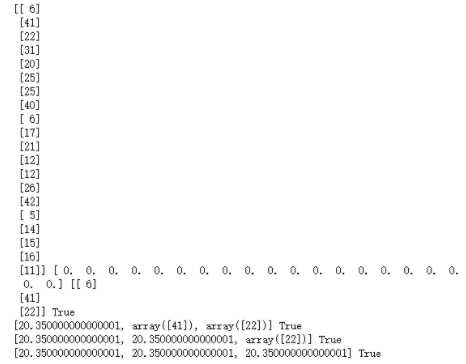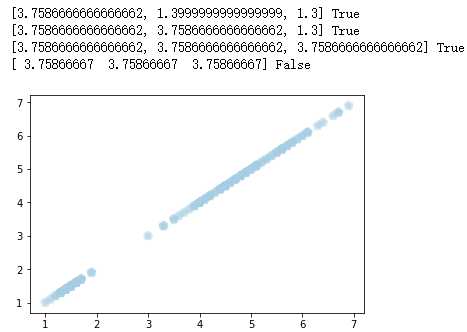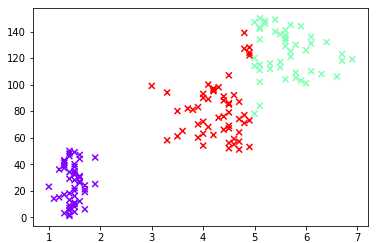标签:函数 marker highlight http 准则 space 返回 new length
import numpy as np
x = np.random.randint(1,50,[20,1])
y = np.zeros(20)
k = 3
#1) 选取数据空间中的K个对象作为初始中心,每个对象代表一个聚类中心;
def initcen(x,k):
return x[:k]
#2) 对于样本中的数据对象,根据它们与这些聚类中心的欧氏距离,按距离最近的准则将它们分到距离它们最近的聚类中心(最相似)所对应的类;
def nearest(kc,i):
d = abs(kc-i)
w = np.where(d == np.min(d))
return w[0][0]
def xclassify(x,y,kc):
for i in range(x.shape[0]):
y[i] = nearest(kc,x[i])
return y
#3) 更新聚类中心:将每个类别中所有对象所对应的均值作为该类别的聚类中心,计算目标函数的值;
def kcmean(x,y,kc,k):
l = list(kc)
flag = False
for c in range(k):
m = np.where(y ==0)
n = np.mean(x[m])
if l[c] != n:
l[c] = n
flag = True
print(l,flag)
return (np.array(l),flag)
#4) 判断聚类中心和目标函数的值是否发生改变,若不变,则输出结果,若改变,则返回2)
kc = initcen(x,k)
flag = True
print(x,y,kc,flag)
while flag:
y = xclassify(x,y,kc)
kc,flag = kcmean(x,y,kc,k)
print(y,kc)

from sklearn.datasets import load_iris
iris = load_iris()
datas = iris.data
iris_length=datas[:,2]
# 用鸢尾花花瓣作分析
x = np.array(iris_length)
y = np.zeros(x.shape[0])
kc = initcen(x,3)
flag = True
while flag:
y = xclassify(x,y,kc)
kc,flag = kcmean(x,y,kc,3)
print(kc,flag)
# 分析鸢尾花花瓣长度的数据,并用散点图表示出来
import matplotlib.pyplot as plt
plt.scatter(iris_length, iris_length, marker=‘p‘, c=y, alpha=0.5, linewidths=4, cmap=‘Paired‘)
plt.show()

from sklearn.cluster import KMeans iris_length = datas[:, 2:3] k_means = KMeans(n_clusters=3) result = k_means.fit(iris_length) kc1 = result.cluster_centers_ y_kmeans = k_means.predict(iris_length) # 画图 plt.scatter(iris_length,np.linspace(1,150,150),c=y_kmeans,marker=‘x‘,cmap=‘rainbow‘,linewidths=4) plt.show()

k_means1 = KMeans(n_clusters=3) result1 = k_means1.fit(datas) kc2 = result1.cluster_centers_ y_kmeans1 = k_means1.predict(datas) print(y_kmeans1, kc2) print(kc2.shape, y_kmeans1.shape, datas.shape) plt.scatter(datas[:, 0], datas[:, 1], c=y_kmeans1, marker=‘p‘, cmap=‘flag‘, linewidths=4, alpha=0.6) plt.show()

聚类--K均值算法:自主实现与sklearn.cluster.KMeans调用
标签:函数 marker highlight http 准则 space 返回 new length
原文地址:https://www.cnblogs.com/chjh/p/9944333.html